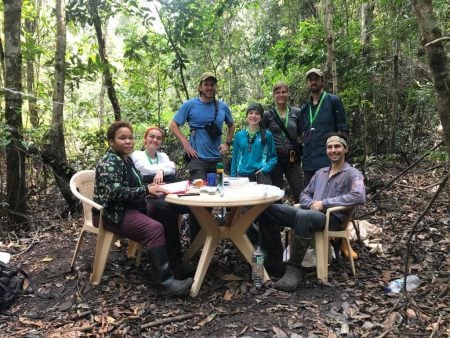
Jared Wolfe and Erik Johnson generously shared their knowledge on Husky Bites, a free, interactive Zoom webinar hosted by Dean Janet Callahan. Here’s the link to watch a recording of his session on YouTube. Get the full scoop, including a listing of all the (60+) sessions at mtu.edu/huskybites.

What are you doing for supper this Monday 4/19 at 6 ET? Grab a bite with Dean Janet Callahan and Jared Wolfe, Wildlife Biologist and Assistant Professor in the College of Forest Resources and Environmental Science at Michigan Tech. Joining in will be Wolfe’s longtime colleague and friend, Erik Johnson, Director of Bird Conservation, Audubon Louisiana.
During Husky Bites, get ready for a wide-ranging, free-wheeling conversation about wild bird research, education and conservation. Be sure to bring your questions for these two world experts.
“Here in the Upper Peninsula of Michigan, there is an incredible diversity of birds that show up to breed in the summer, but many of these birds are decreasing in abundance—they are diminishing,” says Wolfe. “We’ve lost 2.5 billion birds in North America over the past 30 years,” he adds. “Why?”
For Wolfe and Johnson, much of their life and work has become dedicated to finding both why, and how. The two began collaborating at Louisiana State University, where they both earned their PhDs. Among their many joint projects is a book, Molt in Neotropical Birds; Life History and Aging Criteria. The volume, published in collaboration with the American Ornithological Society, describes molt strategies for nearly 190 species based on information gathered from a 30-year study of Central Amazonian birds.

Wolfe has spent 15-plus years working with tropical birds in Africa, Central and South America where he studies effects of climate and habitat change on sensitive bird species and wildlife communities. In North America, he works with managers to integrate wildlife management and conservation into sustainable forest stewardship.
Wolfe joined Michigan Tech in 2018, Determining how birds adapt lifecycle events to climate change and subsequent shifts in food resources is a central facet of his research. He uses monitoring data from California, Hawaii, Costa Rica and Brazil to measure changes in breeding and molting phenology, and survival relative to climate. He also studies bird communities within human dominated landscapes and adjacent habitat patches.
Bird migration is an important focus in the Wolfe Lab at Michigan Tech. “Seasonal movements of birds have captured the imagination of naturalists for millennia,” he says. “The advent of diminutive tracking devices ushered in an era of discovery, where connectivity between breeding and wintering grounds are continually being revealed.”
Johnson has over 15 years of applied ornithological research experience in five countries. He completed his dissertation work studying the effects of forest fragmentation on avian communities at the Biological Dynamics of Forest Fragments Project (BDFFP) in coordination with the Instituto Nacional de Pesquisas da Amazônia (INPA). His primary focus now at Audubon Louisiana involves avian conservation challenges along the Gulf Coast of the United States.

Prof. Wolfe, how did you first get into Wildlife Biology? What sparked your interest?

Growing up in downtown Sacramento, there wasn’t much opportunity to recreate in nature or see wildlife outside the city. There was a strip of riparian forest bordering the American River which served as a refuge from the city. Just a short bike ride from my house I would see coyotes, migratory birds, waterfowl, and beavers all seeking refuge, like me, from the city. These formative experiences helped develop a passion for wild places and wild things which led to a lifelong fascination with plants and animals. Luckily, I learned about the profession of wildlife ecology when I was 18, and never turned back!
What do you like to do in your free time?
I love to go fishing, birding, hiking, camping, hunting, anything that gets me away from social media and my computer!

Could you tell us a little about your family?
Sure, I am from Sacramento, California. My wife, Dr. Kristin Brzeski is a conservation geneticist who is also a professor at CFRES. We have one son, a covid baby, 7 month old Lawrence. We went into the pandemic barely pregnant, and to the surprise of our colleagues, are emerging with an infant!
Prof. Johnson, how did you first get into Wildlife Biology? What sparked your interest?

I suppose I’ve always been into birds. My parents tell stories of me when I was little, being more interested in the pigeons than the lions, elephants, and zebras when we visited zoos. I started really picking up binoculars when I was about 10 and starting keeping bird lists when I was 11. My mom and aunt are casual bird watchers, and my whole family was an outdoorsy sort of family, so they embraced my interest from the beginning. From there I became focused on wildlife biology, ecology, and conservation more broadly.
What do you like to do for fun?
I really love to do anything outdoors—travel, hike, bike, garden. And of course, bird watching. Lately, I’ve been interested in photographing insects, with a particular interest in leafhoppers, planthoppers, and treehoppers. I dabble in guitar and violin, and used to really be into snowboarding, which is much harder to do in Louisiana!
Family and growing up?

I live in Sunset, Louisiana, but grew up in Pittsburgh and was born in Boston. I have family all over the eastern US—my parents are still in Pittsburgh, my younger brother is in New Hampshire, and I have aunts, uncles and cousins in Ohio, North Carolina, New York, and Massachusetts, and more distant connections to Germany, where my mom was born. My wife, Ceci, is from Metairie, Louisiana (just outside of New Orleans), and we’ve been married 15 crazy years.
Read more
Fine Feathers: Migration and Molt Affect How Birds Change Their Colors
